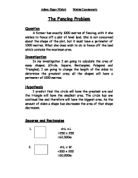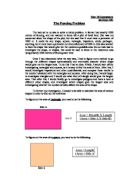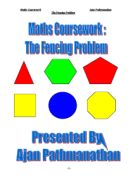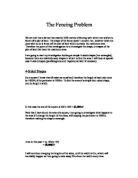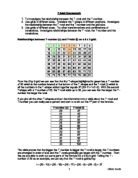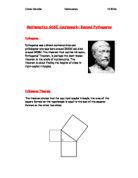The Fencing Problem
Question: A farmer has exactly 1000 metres of fencing, with it she wishes to fence off a plot of level land. She is not concerned about the shape of the plot, but it must have a perimeter of 1000 metres. What she does wish to do is fence off the plot of land, which contains the maximum area. The answer is a circle but in this course work I will try to explain why. All numbers will be rounded to 2 decimal places. Regular polygons have the largest areas This shows that the closer the values of the height and width the larger the area. I made many more of these calculations and created a graph. This graph reinforces that 250 x 250 is the rectangle with the largest area which shows that the shapes with the largest area are those with equal sides. Number of Sides Area 3 48111.11 4 62500 5 68800 6 72168.72 7 73890.13 8 75444.17 9 76318.81 0 76942.09 Conclusion Regular polygons have larger areas than irregular polygons, so a rectangle could have the same perimeter as a square but it wouldn't have as much area. Regular polygons with lots of sides have more area than regular polygons with less sides, so a square could have the same perimeter as a hexagon but the hexagon would have more area. Because regular polygons with more sides have a larger area and a circle has an infinite number of sides a circle is the shape with the largest area. But because the
The Fencing Problem
The Fencing Problem Question A farmer has exactly 1000 metres of fencing, with it she wishes to fence off a plot of level land. She is not concerned about the shape of the plot, but it must have a perimeter of 1000 metres. What she does wish to do is fence off the land which contains the maximum area. Investigation In my investigation I am going to calculate the area of many shapes, (Circle, Square, Rectangles, Polygons and Triangles). I am going to change the length of the sides to determine the greatest area; all the shapes will have a perimeter of 1000 metres. Hypothesis I predict that the circle will have the greatest are and the triangle will have the smallest area. The circle has one continual line and therefore will have the biggest area. As the amount of sides a shape has decreases the area of that shape decreases. Squares and Rectangles 1. A=L x L =250 x 250 =62,500m 2. A=L x W =300 x 200 =60,000m 3. A=L x W =350 x 150 =52,500m 4. A=L x W =499 x 1 =499m 5. A=L x W =490 x 10 =4,900m 6. A=L x W =400 x 100 =40,000m 7. A=L x W =450 x 50 =22,500m 8. A=L x W =475x25 =11,875m 9. A=L x W =425 x
The Fencing Problem.
Year 10 Coursework Jas Singh 10D The Fencing Problem The task set to us was to solve a tricky problem. A farmer had exactly 1000 metres of fencing, and she wanted to fence off a plot of level land. She was not concerned about the shape of the plot, but she said that it must have a perimeter of 1000 m. It could be any shape, square, rectangle, trapezium, circle, pentagon, anything, but it must have a perimeter (or circumference) of 1000 m. She also wanted to have the shape that would give her the maximum possible area. So our task was to investigate the shape, or shapes, that could be used to fence in the maximum area using exactly 1000 metres of fencing each time. Once I had discovered what the task was, I had to figure out a method to go through the different shapes systematically and eventually discover which shape would give me the largest area. To do this I had an idea. Firstly, I would start off by investigating rectangles and squares, as it is easy to find the area of them. After this, I would investigate trapeziums and other quadrilaterals, and compare those results to the results I obtained with the rectangles and squares. After doing this, I would begin to investigate triangles and I would see what kind of triangle would give the largest area. Then after this, I would finally go to investigate polygons and have a look at different sided shapes, and investigate
The fencing problem.
There is a need to make a fence that is 1000m long. The area inside the fence has to have and give the maximum area. I will be investigating which shape would give this . I will be investigating the following shapes * Rectangles * Triangles * Pentagons * Hexagon * Heptagon Prediction I predict that as the number of sides increases the area of the shape will also increases Rectangles I am going to start investigating different shape rectangles, all which have a perimeter of 1000 meters. Below are 2 rectangles showing how different shapes with the same perimeter can have different areas. In a rectangle, any 2 different lengths sides will add up to 500 because each side has an opposite with the same length. Therefore in a rectangle of 100m x 400m, there are two other that are 100m long and 2 sides next tot hem that are opposite each other that are 400m long. This means that you can work out the area if you only have the length of one side. To work out the area of a rectangle with a bas length of 200m, I subtract 200 from 500, giving 300 and then times 200 by 300. I can put this into an equation form. 000 = x(500 - x) Below is a table of results, worked out using the formula. I have gone down by taking 10m off the base (x) every time. Height (m) x Area (m2) 0 500 0 0 490 4900 20 480 9600 30 470 4100 40 460 8400 50 450 22500 60 440
The Fencing Problem
The Fencing Problem We are told that a farmer has exactly 1000 metres of fencing with which she wishes to fence off a plot of land. The shape of the fence doesn't concern her, however what she does wish to do is fence off the plot of land which contains the maximum area. Therefore the point of this investigation is to investigate the shape, or shapes of the plot of land that have the maximum area. I am going to start my investigation looking at simple 4-sided shapes (the rectangles), because there are relatively easy shapes in which to find the area. I will look at special case 4-sided shapes (parallelograms and trapeziums) later if necessary. 4-Sided Shapes For a square I know that all sides are equal and therefore the length of each side must be 1000/4, if the perimeter is 1000m. To find the area of a simple four-sided shape, you do length x width. In this case the are of the square is 250 x 250 = 62,500m² Now that I have found the area of a square, I am going to investigate what happens to the area if I change the length of the sides, still keeping the perimeter to 1000m, therefore making the shape a rectangle. Area in this case = (? -50)(? +50) = 60,000m² I will continue changing the lengths of the sides, until the width is 0m, which will inevitably happen as I am going to take away 50m from the width every time. Area in this case = (?-100)(?+100) = 52,500m²
The Fencing Problem
Yr 10 GCSE Maths Coursework: The Fencing Problem In this investigation I plan to explore various polygons and deduce which type would yield the greatest area while complying with a perimeter of 1000m. I am only investigating regular polygons, because the otherwise would prove to be far too complex and involve an immeasurable amount of data. I will expand on this decision later in the investigation. I intend to find a general formula for the area of any polygon and prove it by applying it to each polygon I explore. The polygons I plan to investigate include: * Triangle (Isosceles, Scalene and Equilateral) * Rectangle * Parallelogram * Pentagon * Hexagon * Octagon * Decagon * A polygon with 15 sides (Pentadecagon) * A polygon with 20 sides (Icosagon) * A polygon with n number of sides (N-Gon) * Circle As you can see, I am working my way up chronologically in aspects of the number of sides on each polygon. For each one I will produce a table of data displaying the progressive areas for the shape; the areas will increase/decrease respectively according to the varying unit (e.g. 50) used for each instance of the shape. For every polygon I will produce a line graph presenting their progressive areas from the table of data. I will indicate the highest value on the graph (i.e. the highest area for the shape) and evaluate it accordingly. The area formulas for each
t shape t toal
T-total Coursework . To investigate the relationship between the T-total and the T-number. 2. Use grids of different sizes. Translate the T-shape to different positions. Investigate the relationship between the T-total and the T-number and the grid size. 3. Use grids of different sizes. Try other transformations and combinations of translations. Investigate relationships between the T-total, the T-number and the translations. Relationships between T-number (x) and T-total (t) on a 9 x 9 grid. 2 3 4 5 6 7 8 9 0 1 2 3 4 5 6 7 8 9 20 21 22 23 24 25 26 27 28 29 30 31 32 33 34 35 36 37 38 39 40 41 42 43 44 45 46 47 48 49 50 51 52 53 54 55 56 57 58 59 60 61 62 63 64 65 66 67 68 69 70 71 72 73 74 75 76 77 78 79 80 81 From the 9 by 9 grid we can see that the first T-shape highlighted in green has a T-number of 20 which is the number located at the bottom of the T-shape and the T-total (t) which is all the numbers in the T-shape added together equals 37 (20+11+1+2+3). With the second T-shape with a T-number of 23, the T-total adds up to 52, you can see that the larger the T-number the larger the total. If you plot all the other T-shapes and put the information into a table about the T-total and T-number you can really see a pattern and start to work out the 1st part of the formula. T-number (x)
Pythagoras Theorem.
Mathematics GCSE Coursework: Beyond Pythagoras Pythagoras Pythagoras was a Greek mathematician and philosopher who was born around 582BC and died around 500BC. The theorem that carries his name, Pythagoras' Theorem, is perhaps the best-known theorem in the whole of mathematics. The theorem is about finding the lengths of sides in right-angled triangles. Pythagoras Theorem The theorem states that for any right-angled triangle, the area of the square formed on the hypotenuse is equal to the sum of the squares formed on the other two sides. Or a2 + b2 = c2 Or 92 + 602 = 612 Pythagorean Triples (3, 4, 5); (5, 12, 13); (7, 24, 25) and etc are all called Pythagorean triples because the satisfy the condition a2 + b2 = c2 The numbers 3, 4 and 5 satisfy the condition The numbers 3, 4 and 5 satisfy the condition The numbers 3, 4 and 5 satisfy the condition Because The perimeter and area of this triangle are Perimeter = 3 + 4 + 5 = 12 units Area = 1/2 x 3 x 4 = 6units2 The perimeter and area of this triangle are Perimeter = 5 + 12 + 13 = 30 units Area = 1/2 x 5 x 12 = 30units2 The perimeter and area of this triangle are Perimeter = 7 + 24 + 25 = 56 units Area = 1/2 x 7 x 24 = 84units2 Results Table Odd numbers for Length of Shortest Side (a). n Length of Shortest Side (a) Length of Middle Side (b) Length of Longest Side (c) Perimeter Area 3 4 5 2



